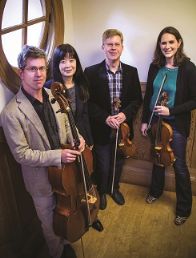|
Symphony
MYSTICAL PLANETS AND LIVELY GERSHWIN ORTIZ AT FINAL SRS CONCERT
by Peter Lert
Sunday, May 4, 2025
Symphony
VSO'S CONCERT MUSIC OF TIME, MUSIC OF PLACE
by Peter Lert
Sunday, April 27, 2025
Choral and Vocal
VOCAL ELEGANCE AND FIRE AT THE 222'S RECITAL APRIL 26
by Pamela Hicks Gailey
Saturday, April 26, 2025
CANTIAMO SONOMA SINGS AN INSPIRED GOOD FRIDAY MOZART REQUIEM CONCERT
by Pamela Hicks Gailey
Friday, April 18, 2025
DRAMATIC SHOSTAKOVICH SYMPHONY CLOSES PHILHARMONIC'S 25TH SEASON
by Terry McNeill
Sunday, April 13, 2025
LARGE COLLEGE OF MARIN AUDIENCE GREETS STOPHER ARTISTRY
by Terry McNeill
Saturday, April 5, 2025
Chamber
FRISSON DELIVERS SHIVERS OF DELIGHT
by Abby Wasserman
Sunday, March 30, 2025
OLD AND MOSTLY NEW IN SRS MARCH CONCERT IN WEILL
by Peter Lert
Saturday, March 22, 2025
Symphony
TWO FORMIDABLE SYMPHONIES AND PURPLE MOUNTAINS AT SRS CONCERT
by Peter Lert
Sunday, February 23, 2025
Chamber
THE PARKER CAPTURES DEMANDING ADES QUARTET AT RAC SEBASTOPOL CONCERT
by Peter Lert
Saturday, February 15, 2025
|
 |
 San Francisco Chamber Players |
COMPELLING CELLO PROMINENCE IN DOMINICAN U. CONCERT
by Vicky Ehrlich
Sunday, February 21, 2016
It could go like this: arrive at Dominican University, park just outside Angelico Hall and perhaps cross a quaint campus bridge over a creek before taking a Hall seat for for a Dominican University Guest Concert Series event featuring the San Francisco Chamber Players.
Faculty pianist June Choi Oh performed with cellist Peter Wyrick the afternoon’s opening work, Beethoven’s A Major Sonata, Op. 69. Mr. Wyrick and Ms. Oh brought off the sonata with beautiful style, energy and deep understanding of the many facets of Beethoven’s mastery. The playing featured many contrasts of volume, tempo, and mood in the first Allegro movement, headlong offset rhythms of the Scherzo, and the stately introduction and then grand sweep of the concluding Adagio.
This third Sonata is sharply different from the first two Op. 5 Sonatas from 1796, and the music revels in the expanded range and more prominent role of the cello. The tempos were just right, never too fast for these consummate players.
The Beethoven was followed by an unusual and charming showpiece for viola and piano, again with instrumental collaboration rather than piano accompaniment. Joy Fellows joined Ms. Oh for the Concertstück by Enescu, a very accessible 1905 composition that gives the listener the whole gamut of emotion, color, and pitch range from the viola, played with full commitment and cohesion on this occasion. Enescu, a splendid violinist, wrote the work as a competition entry at the Paris Conservatoire.
After intermission the entire San Francisco Chamber Players group performed Brahms’ G Minor Piano Quartet, Op. 25, with violinist Dan Carlson joining Mr. Wyrick, Ms. Fellows and Ms. Oh. It was an elegant reading of the 40-minute piece, and the musicians were fun to watch interacting with each other. The sightlines and acoustics of Angelico are very good, albeit the high stage sporadically diminished sonic power, and the message of this glorious 1861 music with manifold majestic themes was palpable. String pitch was excellent, particularly in octave passages in the Brahms, and Mr. Wyrick's usual effortless-seeming clear, expressive sound was as he chose warm, cool, dry and wet as the music demanded. The spiritual slow movement had a touch of sadness, making the C Major flourish at the end so uplifting and satisfying.
A possible programming theme at this concert could be the benefit of a composer’s working relationships with practitioners of specific instruments, which inspires them to write music that fully exploits the expressive possibilities of composer, player, and instrument. The virtuoso Enescu had himself, and Beethoven met the cellist Josef Lincke, who apparently revealed to him new aspects of the instrument’s potential. For Brahms, the Gypsy violinist Eduard Remenyi inspired him to write many Hungarian and Gypsy tunes, and perhaps to make the last movement (Rondo alla Zingarese) wild and crazy, which the ensemble tore through in a way that brought the small audience to their feet at the end.
There was no encore.
|

